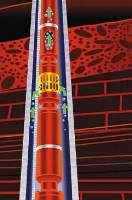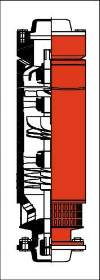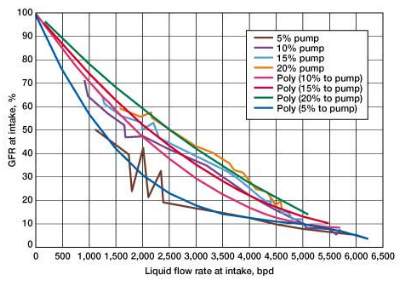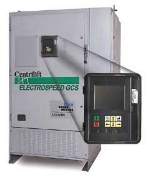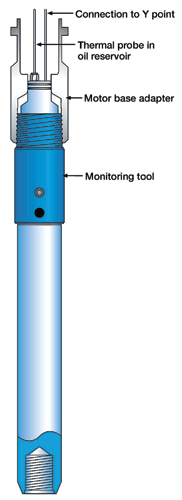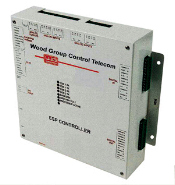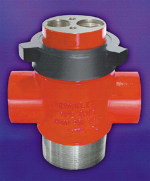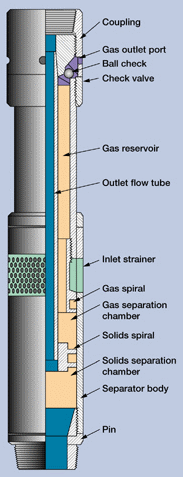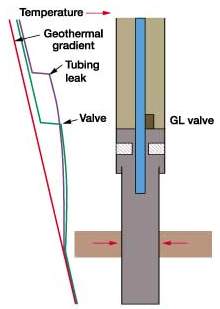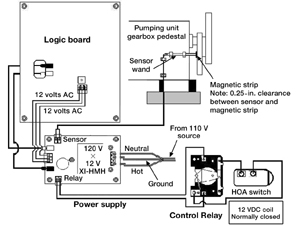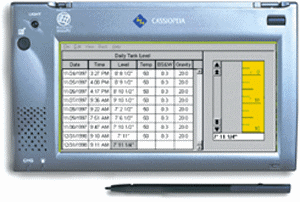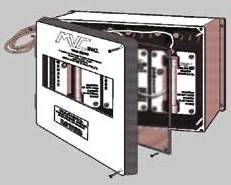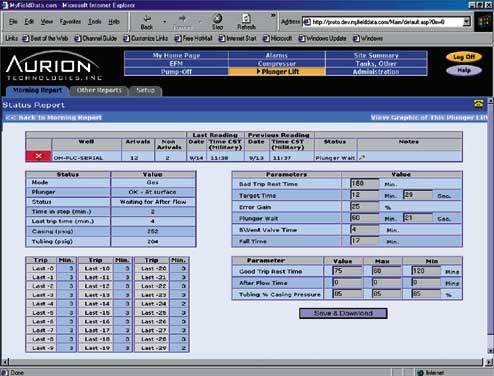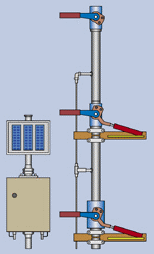What's new in artificial lift
ARTIFICIAL LIFTWhat’s new in artificial liftPart 2 – Twenty downhole / surface system advances from 12 developers / suppliers for electrical submersible (ESP) and other artificial-lift technologyJames F. Lea and Herald W. Winkler, Texas Tech University, Lubbock, Texas; and Robert E. Snyder, Editor Part 1, presented last month, covered 15 recent developments in four categories of artificial-lift technology: beam and progressing cavity pumping (PCP); gas lift; and plunger lift. This concluding article introduces 20 recently introduced innovations from 12 companies. Twelve of the presentations include new downhole and surface ESP systems. The eight "miscellaneous" items cover contributions for various lift categories, such as gas separators, performance monitors / controllers, and equipment upgrades / developments. Electrical Submersible Pumping Described here are six downhole equipment developments / improvements involving: dual completions, pump stages, motors and gas separation / handling. A wellhead for coalbed methane well ESPs is shown. Four monitoring / control systems are described. And formation of a specialized application engineering group is announced. Gas handler for extremely gassy wells. For extremely gassy applications, a new Advanced Gas Handler* has been released by Schlumberger, Fig. 1. The AGH D20-60 is now available for 2,000 to 6,000 bpd applications in 5-1/2-in. and larger casing.
The patented gas handler significantly increases the allowable vapor-to-liquid ratio (VLR) and virtually eliminates "gas locking" by mixing the free gas with the produced fluid. REDA pumps equipped with the gas handler can produce reservoirs with high levels of free gas traditionally lifted by gas lift or jet pumps. The new system can make a well more economical by increasing its drawdown and increasing oil produced. This increases recoverable reserves and extends the well’s economic life. Displays for variable speed drives. Variable speed drives from Schlumberger are now equipped with the RedaSmart* W995T display. The new displays deliver a user interface consistent with other REDA Production Systems switchboard controllers to simplify user setup and field diagnostics. The Wellview software and the Impac data cards incorporated into the display provide easy and quick data downloads from the variable speed drives to a personal computer in the field. Data trending then can be monitored and analyzed through the Wellview software provided with the controller. Large, high efficiency gas separator. The third in a series of high-performance vortex gas separators for high-GOR installations has been introduced by Schlumberger, REDA Production Systems, Bartlesville, Oklahoma. Measuring 4 in. in diameter, the VGSA-D 20-60 delivers greater efficiency than other 400-series gas separators. It is designed for 5-1/2-in. and larger wells producing from 2,000 to 6,000 bpd. The VGSA D20-60 vortex separator’s patented design (Fig. 2) utilizes a natural vortex action created by a specially designed inlet configuration, axial flow inducer, multiple vortex generators and a discharge crossover to provide the most efficient gas separator available for 5-1/2-in. casing. Fig. 3 shows system performance analysis.
Higher efficiency pump stages. New, high efficiency D-series pump stages are available for 5-1/2-in. and larger casing. The D4300N from Schlumberger REDA Production Systems offers high efficiency and the greatest head per stage available in these flowrates. The D4300N is designed for optimum performance in the 3,500 to 5,400-bpd range at 60 Hz. The stage design is optimized to develop higher head per unit length, resulting in more production in a shorter, more cost effective pump. The L16000N provides the highest lift per stage of any pump available in the 11,000 to 20,000-bpd range. Designed for 9-5/8-in. and larger casing, the lift of the L16000N pump is consistently higher through the production range than other pumps in this flow range. Three dual-ESP system completions. Phoenix Petroleum Services Ltd., Aberdeen, Scotland, has designed – and applied three types of ESP completions that can be used to run two ESPs in a single well.
Dual Parallel: More production. The basic rule of thumb in production engineering is: more drawdown, more production. However, with ESPs, more drawdown usually means more horsepower. In some completions, or locations, it is not possible to provide more HP due to surface (generator) or downhole (motor) power limitations. This was the case for one operator where a surface power limitation of 600 hp prevented it from producing more than 10,000 bpd from its wells, which have higher capacities. The solution was to design a completion comprising two independent ESPs producing from the same zone, with fluid pumped up the two sides of an auto Y-tool, then commingled to surface, Fig. 4. The operator has a further 135 wells in the field that can be considered for this type of completion. Dual Concentric: Layers that need to be produced separately. In many oil-producing reservoirs, multiple zones exist, but constraints can prevent the operator from producing more than one layer at a time. Often, this results in more wells having to be drilled. The dual concentric completion can be applied to multi-layered field developments to produce two zones using one wellbore, while maintaining segregation of the produced fluids. The completion is normally run on 5-1/2-in. tubing; a second tubing string of 2-7/8 in. is run inside the 5-1/2 in. (hence the name dual concentric) and packed off inside the bypass, Fig. 4. Above the bypass, a flow crossover maintains isolation of the production from the two zones and routes production from one zone into the tubing, while the other zone is produced up the concentric annulus. Dualife Completion: Less workovers. This completion design allows two ESPs to be run, the second as a backup which can be started when the first fails. Such completions are desirable in wells where access to the wellbore is difficult, e.g.: subsea, where rig availability is limited, or where workover costs are high. Justifying a system of this type is driven by accessibility and intervention cost. The major benefit of this type of system is half the number of workovers. These three completion types are made possible by innovative application of the simple bypass system; a tool originally invented to allow logging access below an ESP. New high-volume pump stages. Three new high-volume pump stages have been introduced by Centrilift, a division of Baker Hughes, Claremore, Oklahoma, Fig. 5. Two new sizes complement the 862 series pump line – the WIJ 500 and the WIJ 700. These pumps have BEPs of 17,000 bpd (500 gpm), and 24,000 bpd (700 gpm), respectively.
There also is a new 10-in. diameter pump, the WJJ1200, which peaks at 41,000 bpd (1,200 gpm). All three designs feature high efficiencies (80% or greater) and bolted-bowl designs with trimmable impellers. Standard material for these stages is nickel-aluminum-bronze. Optional features include corrosion-resistant fasteners and tungsten carbide bearings for abrasive applications. These high-volume stages are the best choice for water source wells, as well as applications in the mining and geothermal industries. In the existing 675 pump series, four sizes have been added. The HC7800, HC10000, HC12500 and HC16000. With BEP efficiencies of 73.5%, 74.8%, 77.3% and 77%, respectively, these stages are among the most efficient in the industry. They also offer significantly greater head per stage, resulting in shorter pump systems. This is a particular advantage when using these sizes for horizontal pumping systems. The higher head per stage translates into fewer stages and shorter pumps. This allows shorter skids and pads, and lowers overall installation cost. The 675 series is a conventionally housed submersible pump constructed of Ni-resist stages as standard. All run-time-enhancing abrasion resistant technology is available, so these pumps will perform in the most severe conditions. Large motor developments. A premium line of high-horsepower ESP motors for use in 8-5/8-in. or larger casing has been developed by Centrilift. With single units rated through 1,000 hp and tandem ratings through 2,000 hp, these giants (Fig. 6) find usage in dewatering or high-temperature geothermal applications, as well as oilfield recovery through 60,000 bpd. The vacuum pressure impregnated epoxy stator and protected end turns, coupled with a superior bearing and mechanical package, make these motors the right choice when high workover costs or reliability demand special attention. Variable frequency controller for ESPs. A new generation of variable frequency controllers is available, Fig. 7. The Electrospeed GCS from Centrilift features a graphic display for user-friendly data acquisition, system setup and real-time data retrieval. The system includes a digital data recorder, programmable logic functionality and a high-speed internal communications bus for easy system expansion.
The SelectWave inverter algorithm allows the user to choose between a conventional six-step or a pulse-width modulated output voltage waveform. The six-step waveform is the proven waveform of choice for most ESP applications. However, in applications where motor temperature rise is critical, the pulse-width-modulated waveform, when used in conjunction with a sine wave filter, provides the motor with the best possible waveform for cooler operation. Outdoor configurations of the Electrospeed GCS controller offer a patented cooling system that eliminates the need for air conditioning of its electronic components, even in the hottest climates.
ESP downhole monitoring systems. Centrilift has unveiled two new downhole-monitoring solutions for use with their ESPs. The PumpMate (Fig. 8) is the premium downhole monitoring system for use with Centrilift ESPs. The real-time measuring system displays well pressure and temperature, motor temperature and electrical ground fault detection. This accurate and reliable tool has proven extremely popular in ESP wells where downhole data is crucial for continuous ESP system operation. The Centaur system is the economic solution for monitoring well pressure, well temperature or motor temperature in an ESP well. This tool provides important downhole information required for ESP production optimization and system protection. Both the Centaur and the PumpMate systems communicate using the ESP power cable, eliminating the requirement for an external I-wire. They have many surface communication options available, from serial communications to local display. A popular configuration for these downhole-monitoring instruments is a closed loop system that operates a Centrilift variable speed controller (VSC) via pump intake pressure in conjunction with a shutdown signal on ESP motor temperature. Applications Engineering Group. Centrilift has announced formation of an engineering group dedicated to applications engineering at their headquarters in Claremore, Oklahoma. "With all the new technology and changes in our industry, we believe a dedicated Application Group will help our customers better understand ESP design considerations," said Mick Underwood, the group’s manager. The idea is to provide technical assistance to customers and field locations so that potential design issues can be addressed before a pump is run into a well. The Group has access to all Centrilift engineering functions, as well as current literature on all subjects related to ESP applications. Automation controller for ESP. Wood Group ESP (WGESP), Midland, Texas, and Wood Group Control Telecom, L.P. (WGCT) provide the electrical submersible pump sector of the oil / gas industry with a new method of automation and control, Fig. 9. This unique system provides for protection, control, monitoring and retrieval of information from ESP systems. WGCT’s hardware, firmware, software and engineering services offer an innovative means of addressing ESP-equipped wellsites and their associated problems.
The motor controller interfaces seamlessly with master supervisory control and data acquisition (SCADA) software systems. The controllers are comprehensive and flexible devices using the latest advances in hardware, software and telecommunications. They offer control, motor protection, data acquisition and data analysis capabilities previously unavailable. The construction and modular features (options) of the controller allow it to be configured as: a simple motor controller; a component of an existing SCADA system; or a full-function, stand-alone device addressable via the supplier’s software from any point in the world. Options can be added to any data from all parameters in real time and allow graphical trending using Windows-based software programs such as Excel, eliminating the need for most personnel to learn new software programs. The new products interface with external devices, such as downhole sensors that allow data logging of ESP and reservoir data. The developer has researched and interfaced with all major sensors on the ESP market. ESP wellhead for coalbed methane wells. R&M Energy Systems, Houston, is meeting the needs of coalbed methane producers by supplying innovative products that meet application requirements and optimize system performance. The new Hercules CMK Wellhead was developed based on the needs of producers who use ESPs in shallow, coalbed methane wells, Fig. 10. Its rugged construction makes it ideal for this type of service.
The design of the new wellhead is highlighted by a variety of performance-enhancing features, including :
The system is designed for 1,500-psi working pressure, 3,000-psi test and 65,000-lb maximum body load.
Miscellaneous Eight items under this category cover four systems for monitoring and controlling pump / motor performance; fiberoptic downhole gas lift monitoring; a downhole gas separator for beam pumps / PCPs / ESPs; a surface chemical soapstick launcher; and new elastomers for PCPs. Downhole gas separator. The Spinner Gas Separator is a new downhole product being developed for low- and high-flow-rate wells by the Cavins Corp. of Houston. A drawing is shown in Fig. 11, with a Sandtrap Desander for separating solids. It attaches to the intake of progressing cavity and beam pumps. With electrical submersible pumps, it is installed with a shroud. Gas separated in the unit is returned to the casing annulus at the top of the unit. If a solids separator is used with the device, solids are collected in a mud anchor attached to the lower end. Lab tests at low- and high-fluid-flow rates with air and water removed all of the air before it reached the pump. For example, at a simulated water flowrate of 1,600 bpd through a 2-3/8-in. tube separator with an air flow of 3,600 cfpd up a 5-1/2-in. casing, 100% of the air was removed from the water. The spinning fluid motion down through the gas separation chamber, produced by incoming fluid flow down through the stationary gas spiral, moves all bubbles onto the outlet tube at the center of the chamber. There, the bubbles combine into large, torus-shaped bubbles that separate from the downward liquid flow and float up into the gas reservoir. When height of the gas column and the resulting pressure in the reservoir become high enough to open the check valve, the gas escapes back into the casing annulus. The inlet strainer also helps produce the efficient separation. Much of the gas goes up the casing annulus without entering the separator. Small holes in the strainer, which are large enough to let solids go through without plugging the strainer, reduce the amount of gas into the separator. From the separation chamber, the gas-free liquid flows down through the solids spiral. The vortex flow produced below the solids spiral, and gravity forces, move the solids down into the mud anchor. Clean fluid reverses direction in the vortex flow and moves up the outlet tube to the pump. Any dissolved gas that is released in the solids spiral and the outlet flow tube will reach the pump. Field tests are underway to evaluate the design in a wide range of well conditions. Gas-lift monitoring with fiberoptic technology. SENSA, Houston, has developed a downhole technology using long-distance optic temperature monitoring. This is the first of the permanent logging systems the industry has developed. The distributed temperature system detects temperature at an accuracy of up to 0.5°F, along 10 km of optic fiber. The method records the temperature at 1-m intervals along the fiber each time a light is launched from the surface laser. Operators use the system in the North Sea to monitor downhole gas-lift valve operations, where the optic fiber is disposed inside a specialized, thick-walled continuous tube, attached to the production tubing OD (Woodrow, C. K. and Drummond, E., "Heat seeking laser sheds light on Tern," paper SPE/IADC 67729, SPE/IADC Drilling Conference; Amsterdam, Feb. 27 – March 1, 2001). The optic fiber and tube penetrate the wellhead and are connected to surface instrumentation that is generically described as Optical Time Domain Reflectometry (OTDR) – a surface optic-electronics package that contains a laser and highly sensitive optical detectors. The application used in monitoring gas-lift operations makes use of the temperature change caused when gas expands through the gas-lift valve downhole. This point of gas expansion affects the local temperature at that depth, resulting in a minute temperature change in the wellbores. The operator sees, at surface in real time, which valve is operating, Fig. 12.
The system is accurate enough to track produced-fluid production slugs up the well, and show total temperature of the lift gas as it proceeds from the compressor, down the well or subsea pipeline, and its heating as it goes down the well. Gas-lift operators can use this new technology to monitor the entire gas-lift system. Optic technology applied to pump off control. D-Jax Corp., Midland, Texas, announced availability of an improved version of the company’s Penny Pincher pump off control. This innovation is important, as it marks the first time a patent has been granted for application of fiberoptic technology to pump off controls for reducing effects of high-voltage surges and lightning strikes. Historically, oilfield electric control devices have been susceptible to damage, often catastrophic, from direct lightning strikes and strong electric supply surges. Research and testing has shown that fiber optics are an excellent insulator which provide protection from powerful electric spikes. D-Jax uses fiberoptic cable to isolate the Penny Pincher’s main logic board from the power supply, thus reducing the susceptibility of catastrophic damage from electrical spikes, Fig. 13.
Digital Web-based oilfield data collection. FieldDIRECT, a new Web-based oilfield data collection service from the IHS Energy Group, Englewood, Colorado, allows field personnel to quickly collect / transmit daily production and other data for use at the office or any authorized location worldwide. It minimizes errors by eliminating need for data re-entry, and it allows the field operator to focus on other important duties. The system also benefits engineers and operations executives, who can use it to track current production, and generate data needed to diagnose / analyze trends to maximize production. The service requires minimal up-front investment, and it avoids the downtime and lost productivity that usually accompany adoption of a new data-collection system. Because the system is a service, pricing is cost-efficiently calculated on a per-well, per-month basis. Field personnel input the daily data, like tank levels, gas chart readings, associated pressure readings and other information into a handheld computer, Fig. 14. These instruments, based on Windows CE, are the size of a small book and weigh less than 2 lb. All input is through a simple graphic interface on the screen that includes a map of well locations and associated gathering sites. All data is entered with a pen-like stylus using graphic controls on the computer screen. Each day, data is transferred through a secure link using a built-in modem to the FieldDIRECT Internet database. The system tracks all data coming in from a number of different sources and performs needed allocation and adjustment to bring the data down to an individual well or producing zone.
A Windows application called Production Explorer can be installed on as many computers as needed to view daily operational plots / reports. This allows users to view data from any location, as long as an Internet connection is available. Data can be exported into other external applications such as Word, Excel, Access, and proprietary corporate databases. Other systems allow data entry using the keypad on a normal touch-tone phone. Surge protection for medium voltage. The WS-Series surge protection device, designed especially for medium-voltage motor and pump applications, is available from MVC of Amarillo, Texas, Fig. 15. Through use of its patented design, the device has been in the field for over five years, protecting equipment from damaging spikes and surges.
The WS-Series, as are all of MVC’s SPD units, is designed so that it is not ground dependent. It is difficult to find protection for motors and pumps that is not ground dependent. Many surge protection devices shunt the over-voltage to ground, which is dangerous and a potential violation of the NEC. The WS-Series protects equipment, with applications from 1,000 to 4,160 VAC. The MV-Series SPD (120 to 480 VAC) can be used to protect low-voltage artificial lift applications. The ICP-Series (40 DC to 120 VAC) is used in conjunction with the MV-Series and WS-Series to protect PLC and solid state controls. The ICP-Series uses an eight-pin base for its installation, and has an alarm pin to contact when failure is indicated. It is available in series and parallel configurations. Oilfield automation now available on web. SCADA-type systems, previously available only to major oil companies, now are being provided by Aurion Technologies, Dallas, Texas, to even the smallest operator, via the Internet. Data is collected from remote terminal units (RTUs) in the field and sent to a data warehouse at the Dallas INFOMART where it is stored and then distributed through the worldwide web, Fig. 16.
No special software or dedicated host is required – just an Internet connection and a password. This capability gives the operator access to his data from any Internet connection in any location, i.e., there is no requirement to be "in the office." Alarm capability also is available through several different means. Alarms can be sent to a pager, to a phone number or an E-mail address. Aurion provides communication and RTU selection, so the operator does not need to hire programers and technicians to design, install or maintain the system. The Aurion pump-off controller is a load-based system that can use either a polished rod load cell or a beam-mounted transducer to monitor rod load. Dynamometer cards and historical data such as run times, cycle time and rod loads can be retrieved and displayed over the Internet. Operational parameters also can be adjusted without a trip to the field. If a meter run is on the same location, electronic flow measurement can be added through the same RTU, allowing a single communication device to retrieve data from two field devices. This makes communications more cost effective. The developer’s plunger lift controller is a proportional-response, intelligent controller that can automatically adjust operational parameters to help optimize the well’s production and operation. Operational parameters can be adjusted from the operator’s desk through a personal computer. Historical data is also retrieved and displayed. The controller can operate in time or pressure modes. Again, if a meter run is on the same location, electronic flow measurement can be added through the same RTU. In addition to pump-off control and plunger-lift control, the growing list of web-enabled products and services includes electronic flow measurement (custody transfer or allocation), compressor automation and tank level monitoring. The communication systems are designed and installed to best suit the customer’s situation and allow data retrieval in any situation or location. Communications options include radio, cellular, CDPD, microburst or even satellite. Automatic soapstick launcher. Unloading fluid from aging gas wells using foaming agents (soap sticks) can be greatly enhanced with use of J&J Oilfield Service’s Automatic Soapstick Launcher, manufactured in Perry, Oklahoma, Fig. 17. By keeping soap sticks loaded in the device and dropped at predetermined intervals, the operator keeps the well from liquid loading after the previous stick is depleted. The number of sticks and timing of drops can be determined by observing the well’s response to the chemicals; and the timing device can be set by the operator.
This concept is not new. J&J has tested this model in all temperature extremes across six states, and the result has been virtually trouble-free design. The improved model works with all soap sticks – regardless of chemical makeup that can affect consistency, which makes some sticks softer than others, resulting in jamming problems. Combined with the right formula of soap stick for the fluid’s composition, this launcher has substantially increased gas production in 90% of the wells in which it has been installed. New elastomer for progressing cavity pumps. A new elastomer for high-temperature application of LIFTEQ progressing cavity pumps has been developed by the Centrilift and Inteq divisions of Baker Hughes Inc., Fig. 18. The LT3001 elastomer has been dynamically tested in a closed-loop system at temperatures of up to 315°F, with no indication of degradation of the pump. In addition to the high temperature, the test environment included a heavy crude oil fluid with gas injected to simulate live well conditions. The bonding system used to adhere the elastomer to the pump tube also has proven dependable in separate testing with temperatures to 347°F. In the elastomer bond test, a sample was aged for six days in heavy crude at test temperature, prior to bonding analysis. The LT3001 will be added to the existing LIFTEQ LT2000
and LT3000 elastomers series.
|
- Applying ultra-deep LWD resistivity technology successfully in a SAGD operation (May 2019)
- Adoption of wireless intelligent completions advances (May 2019)
- Majors double down as takeaway crunch eases (April 2019)
- What’s new in well logging and formation evaluation (April 2019)
- Qualification of a 20,000-psi subsea BOP: A collaborative approach (February 2019)
- ConocoPhillips’ Greg Leveille sees rapid trajectory of technical advancement continuing (February 2019)

